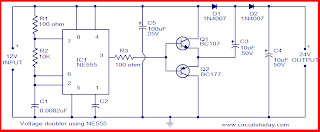A simple intercom circuit designed based on transistors is shown here. This intercom circuit does not require a changeover switch and you can use it just like a telephone and a ringer circuit is also included.
IC1 UM66 and transistor Q1 forms the ringer section. When pushbutton switch S1 is pressed UM66 produces a musical tone. This tone is amplified by Q1 and is coupled to the collector of Q2. Condenser Mic M1 is used to pick the conversation and Q2 is used to amplify it. R2 powers the condenser Mic while C2 is the DC decoupling capacitor for the amplifier stage based on Q2. The next stage of the circuit is a transformer coupled push pull amplifier stage based on L1, Q3 and Q4. Capacitor C5 is the power supply filter while capacitor C4 couples the output of the push pull amplifier to the ear piece. source circuitstoday.
IC1 UM66 and transistor Q1 forms the ringer section. When pushbutton switch S1 is pressed UM66 produces a musical tone. This tone is amplified by Q1 and is coupled to the collector of Q2. Condenser Mic M1 is used to pick the conversation and Q2 is used to amplify it. R2 powers the condenser Mic while C2 is the DC decoupling capacitor for the amplifier stage based on Q2. The next stage of the circuit is a transformer coupled push pull amplifier stage based on L1, Q3 and Q4. Capacitor C5 is the power supply filter while capacitor C4 couples the output of the push pull amplifier to the ear piece. source circuitstoday.














































